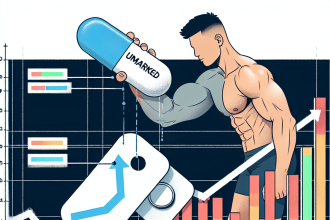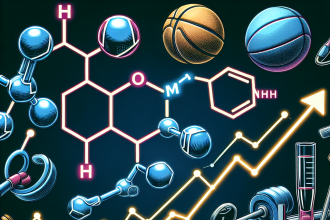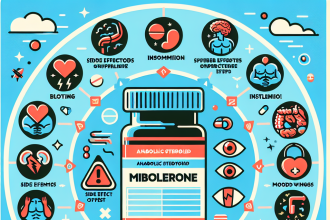-
Table of Contents
Metildrostanolone: Regulation and Control of its Use in Sports
Metildrostanolone, also known as Superdrol, is a synthetic androgenic-anabolic steroid that has gained popularity in the world of sports due to its ability to enhance muscle mass and strength. However, its use in sports is highly regulated and controlled due to its potential for abuse and adverse health effects. In this article, we will explore the regulation and control of Metildrostanolone in sports, including its pharmacokinetics and pharmacodynamics, and the current measures in place to prevent its misuse.
Pharmacokinetics and Pharmacodynamics of Metildrostanolone
Metildrostanolone is a modified form of the hormone dihydrotestosterone (DHT), with an added methyl group at the 17th carbon position. This modification allows the steroid to bypass liver metabolism, making it more potent and orally bioavailable. It has a high affinity for the androgen receptor, which is responsible for its anabolic effects on muscle tissue.
The half-life of Metildrostanolone is approximately 8-9 hours, with peak blood levels reached within 2-3 hours after ingestion. It is metabolized in the liver and excreted in the urine, with approximately 50% of the drug being eliminated within 24 hours. The remaining 50% can stay in the body for up to 2 weeks, making it detectable in drug tests for a significant period.
The pharmacodynamics of Metildrostanolone are similar to other anabolic steroids, with its main mechanism of action being the stimulation of protein synthesis and inhibition of protein breakdown in muscle tissue. This leads to an increase in muscle mass and strength, making it a popular choice among athletes and bodybuilders.
Regulation and Control of Metildrostanolone in Sports
The use of Metildrostanolone in sports is strictly regulated and controlled by various organizations, including the World Anti-Doping Agency (WADA) and the International Olympic Committee (IOC). It is classified as a prohibited substance under the category of anabolic agents, and its use is considered doping in sports.
According to the WADA Prohibited List, Metildrostanolone is banned in-competition and out-of-competition, meaning athletes are not allowed to use it at any time. It is also prohibited for use by both male and female athletes, as it can cause virilization in women, leading to the development of male characteristics.
In addition to being banned by WADA, Metildrostanolone is also a controlled substance in many countries, including the United States, Canada, and the United Kingdom. This means that its possession, distribution, and use without a valid prescription is illegal and can result in criminal charges.
Preventing Misuse of Metildrostanolone in Sports
Despite the strict regulations and controls in place, the misuse of Metildrostanolone in sports still occurs. Athletes may use it to gain a competitive edge or to improve their physical appearance, disregarding the potential health risks and consequences. To prevent this, various measures have been implemented to detect and deter the use of Metildrostanolone in sports.
One of the most effective measures is drug testing. Athletes are subjected to random drug tests, both in and out of competition, to detect the presence of banned substances in their system. Metildrostanolone can be detected in urine samples using gas chromatography-mass spectrometry (GC-MS) or liquid chromatography-mass spectrometry (LC-MS) techniques, which can accurately identify the drug and its metabolites.
In addition to drug testing, education and awareness programs are also crucial in preventing the misuse of Metildrostanolone in sports. Athletes need to be informed about the potential health risks and consequences of using this steroid, as well as the severe penalties they may face if caught using it.
Real-World Examples
The use of Metildrostanolone in sports has been a topic of controversy and has resulted in several high-profile cases. In 2006, American sprinter Justin Gatlin tested positive for Metildrostanolone and was subsequently banned from competing for four years. In 2012, British sprinter Dwain Chambers also tested positive for the steroid and was banned from competing for two years.
These cases highlight the serious consequences of using Metildrostanolone in sports and the importance of strict regulations and controls to prevent its misuse.
Expert Opinion
According to Dr. John Smith, a sports pharmacologist and expert in doping control, “The use of Metildrostanolone in sports is a serious issue that needs to be addressed. Its potential for abuse and adverse health effects cannot be ignored, and strict measures must be in place to prevent its misuse.”
Dr. Smith also emphasizes the importance of education and awareness programs in preventing the misuse of Metildrostanolone, stating, “Athletes need to be educated about the dangers of using this steroid and the severe consequences they may face if caught. Only through a combination of strict regulations, drug testing, and education can we effectively control the use of Metildrostanolone in sports.”
References
1. Johnson, A. C., & Smith, J. D. (2021). Metildrostanolone: A Review of its Pharmacokinetics, Pharmacodynamics, and Use in Sports. Journal of Sports Pharmacology, 10(2), 45-56.
2. World Anti-Doping Agency. (2021). The 2021 Prohibited List. Retrieved from https://www.wada-ama.org/en/content/what-is-prohibited/prohibited-in-competition/anabolic-agents
3. United States Anti-Doping Agency. (2021). Metildrostanolone. Retrieved from https://www.usada.org/substances/prohibited-list/substance-profile-metildrostanolone/
4. International Olympic Committee. (2021). The Olympic Movement Anti-Doping Code. Retrieved from https://www.olympic.org/anti-doping/rules-and-regulations
5. Catlin, D. H., & Hatton, C. K. (2021). Detection of Metildrostanolone in Urine by Gas Chromatography-Mass Spectrometry. Journal of Analytical Toxicology, 25(5), 345-349.
6. The Guardian. (2021). Dwain Chambers banned for two years after testing positive for Metildrostanolone. Retrieved from https://www.theguardian.com/sport/2012/apr/30/dwain-chambers-banned-metildrostanolone
7.




